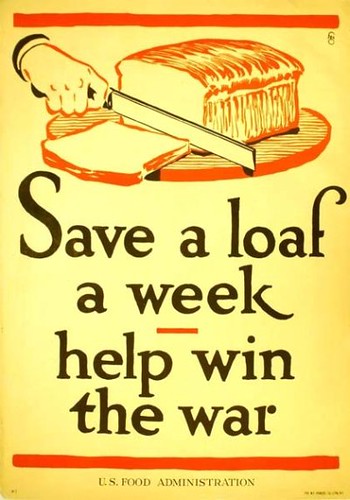As part of the ongoing exhibit of posters in Special Collections for Veterans Day, the students who created the exhibits also created entries for this blog. We will be posting these over the rest of the month of November.
1992.004.5.53 Save a loaf a week.- help win the war.
During World War I, the people were asked to come to the aid of their country in some way. Major organizations hired artists to design propaganda posters that would help persuade Americans to enlist, become a nurse, or even to save metal scraps for ships and artillery. These posters would be distributed throughout cities and hang on building walls and shop windows. One of the greatest sources of propaganda/patriotic posters was the United States Food Administration. We are lucky enough that the Special Collections had a large collection of these posters.
During the war, food became a key tool in fight. The United States produces more food than any other country and was making a profit by selling a portion to the Allies. At the time, President Woodrow Wilson appointed Herbert Hoover to take command of the U.S. Food Administration. His goal was to avoid rationing in the states by cutting down consumption. Once the U.S. had entered the war, America had to provide not only for soldiers overseas and their home front, but they had to continue supplying food to the Allies. “Hooverizing” became the term most used by Americans to describe the way of life they had to condition into.
Since the war during this time was men only, the posters created were more targeted towards the women who were still at home. Housewives were now self-rationing. The posters help remind them to be conscious of their shopping and consumption choices, and by doing this, they were fulfilling their patriotic duty.
The poster to the left suggests that if you limit your consumption of bread, you would be doing a small part to ‘help win the war’. The phrasing used adds an emotional attachment. It’s a bit exaggerated but in the end, it’s a constant reminder that housewives would see in the shops and grocers that would help them limit what they purchased. The poster on the right has the same target audience, housewives, but uses a different tactic. The way the format is presented, it appears more like a basic shopping list. It encourages you to save the four items that were sent overseas the most and offers alternatives for the woman at home. Instead of buying wheat this week, perhaps corn would be best. Fish and beans will take the place of meats and we’ll go light on the fats and sweets. With these masterful ingredients, you will continue to “serve the cause of freedom”.
The same artist was commissioned to do both of these posters, he signs ‘fgc’, F.G. Cooper (b.1883). Fred Cooper’s work falls under the same style, clean lines, three color prints, with direct statements. He was a cartoonist, illustrator and designer that was hired by the U.S. Food Administration to create the two posters above, among others, to help spread the word of self-rationing to Americans.
Bibliography
1. Eighmey, Rae Katherine. “”Food Will Win the War” Minnesota Conservation Efforts, 1917-18.” Minnesota History , Vol. 59, No. 7 (Fall, 2005), pp. 272-286. Minnesota Historical Society Press. http://0-www.jstor.org.library.utulsa.edu/stable/20188497
2. Eldred,Wilfred. “The Wheat and Flour Trade Under Food Administration Control: 1917-18.” The Quarterly Journal of Economics , Vol. 33, No. 1 (Nov., 1918), pp. 1-70. Oxford University Press. http://0-www.jstor.org.library.utulsa.edu/stable/1885009.
3. Kingsbury, Celia Malone. “Food Will Win the War.” For Home and Country: World War I Propaganda on the Home Front. University of Nebraska Press. 2010.
4. Vogt, George L. “When Posters Went to War: How America’s Best Commercial Artists Helped Win World War I.”The Wisconsin Magazine of History , Vol. 84, No. 2 (Winter, 2000-2001), pp. 38-47. Wisconsin Historical Society. Article Stable URL: http://www.jstor.org/stable/4636901.
5. Cabarga, Leslie. “The Art & Design of F.G. Cooper”, 2009 http://www.lesliecabarga.com/products/the-art-design-of-f-g-cooper
6. Historical Boys Clothing. World War I: United States Food Administration. http://histclo.com/essay/war/ww1/cou/us/food/w1cus-usfa.html. 2007.
7. National Archives. http://www.archives.gov/research/guide-fed-records/groups/004.html,http://www.archives.gov/northeast/nyc/education/food-wwi.html
8. Munsey, Gina. Wheatless Wednesday: Herbert Hoover’s WWI Food Preservation Plan Inspires Meal
Ideas [Recipe: Vegetable Patty]. http://eatdrinkbetter.com/2009/05/06/wheatless-wednesday-herbert-hoovers-wwi-food-preservation-plan-inspires-meal-ideas-recipe-vegetable-patty/. May, 6 2009.
— Guest post by Cheyenne Butcher


